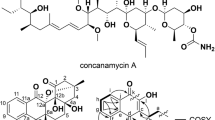Abstract
The luciferin-binding protein (LBP) of the dinoflagellate Gonyaulax polyedra is encoded by large gene family with at least two different members. To more fully understand the expression and genomic organization of this gene family, 40 full-length LBP cDNAs were isolated and mapped with the restriction enzymes Xho I, Eco RI, Pvu II and Hind III. All cDNAs isolated could be placed into one of two groups called LBPα and LBPβ. Two LBPα group cDNAs were completely sequenced and were found to share 99% identity at both the nucleotide and protein levels. One LBPβ cDNA was sequenced and was found to share only 86% sequence identity with the LBPα group at both the nucleotide and protein levels. Both groups of message appear to be expressed at nearly equal levels since (1) two-dimensional gels of purified LBP show two protein isoforms present in roughly equal amounts and (2) northern blots using group-specific probes suggest that cellular levels of LBPα and LBPβ mRNAs are identical. Genomic Southern blots using group-specific probes suggests that the copy number of both gene groups is very similar and that LBP gene loci are organized as tandem repeats of either LBPα or LBPβ sequences.
Similar content being viewed by others
References
Altschul SF, Gish W, Miller EW, Lipman DJ: Basic local alignment search tool. J Mol Biol 215: 403–410 (1990).
Ausubel FM, et al.. Current Protocols in Molecular Biology. Green Publishing Associates/Wiley Interscience, New York (1987).
Church GM, Gilbert W: Genomic sequencing. Proc Natl Acad Sci USA 81: 1991–1995 (1984).
Desjardins M, Morse D: The polypeptide components of scintillons, the bioluminescence organelles of Gonyaulax polyedra. Biochem Cell Biol 71: 176–182 (1993).
Fritz L, Morse D, Hastings JW: The circadian bioluminescence rhythm of Gonyaulax is related to daily variations in the number of light-emitting organelles. J Cell Sci 95: 321–328 (1990).
Guillard RRL, Ryther JH: Studies on marine planktonic diatoms: Cyclotella nana Hufstedt and Denotula confervacea (Cleve) Gran. Can J Microbiol 8: 229–239 (1962).
Hastings JW, Astrachan L, Sweeney BM: A persistent daily rhythm in photosynthesis. J Gen Physiol 45: 69–76 (1961).
Hastings JW, Dunlap JC: Cell free components in dinoflagellate bioluminescence. Meth Enzymol 133: 307–330 (1986).
Hastings JW, Sweeney BM: A persistent diurnal rhythm of luminescence in Gonyaulax polyedra. Biol Bull 115: 440–458 (1958).
Herzog M, Soyer M-O: Distinctive features of dinflagellate chromatin. Absense of nucleosomes in a primitive species Prorocentrum micans. Eur J Cell Biol 23: 295–302 (1981).
Johnson CH, Roeber JF, Hastings JW: Circadian changes in enzyme concentration account for rhythm of enzyme activity in Gonyaulax. Science 223: 1428–1430 (1984).
Lang BF, Burger G: A rapid, high resolution DNA sequencing gel system. Anal Biochem 188: 176–180 (1990).
Lee D-H, Mittag M, Sczekan S, Morse D, Hastings JW: Molecular cloning and genomic organization of a gene for luciferin binding protein from the dinoflagellate Gonyaulax polyedra. J Biol Chem 268: 8842–8850 (1993).
Maxson R, Cohn R, Kedes L: Expression and organisation of histone genes. Annu Rev Genet 17: 239–277 (1983).
Morse D, Milos PM, Roux E, Hastings JW: Circadian regulation of bioluminescence in Gonyaulax involves translational control. Proc Natl Acad Sci USA 86: 172–176 (1989).
Morse D, Pappenheimer AMJJr, Hastings JW: Role of a luciferin-binding protein in the circadian bioluminescent reaction of Gonyaulax polyedra. J Biol Chem 264: 11822–11826 (1989).
Nakamura H, Kishi Y, Shimomura O, Morse D, Hastings JW: Structure of dinoflagellate luciferin and its enzymatic and non-enzymatic air oxidation products. J Am Chem Soc 111: 7607–7611 (1990).
Nicolas MT, Morse D, Bassot JM, Hastings JW: Colocalization of luciferin binding protein and luciferase to the scintillons of Gonyaulax polyedra revealed by double immunolabeling after fast freeze fixation. Protoplasma 160: 159–166 (1991).
O'Farrell PH: High resolution two-dimensional electrophoresis of proteins. J Biol Chem 250: 4007–4021 (1975).
Roenneberg T, Hastings JW: Cell Movement and Pattern Formation in Gonyaulax polyedra 1. Marcel Dekker, New York (1991).
Sambrook J, Fritsch EF, Maniatis T: Molecular Cloning: A Laboratory Manual, 2nd ed. Cold Spring Harbor Laboratory Press, Cold Spring Harbor, NY (1989).
Sulzman FM, Krieger NR, Gooch Dv, Hastings JW: A circadian rhythm of the luciferin binding protein from Gonyaulax polyedra. J Comp Physiol A 128: 251–257 (1978).
Sweeney BM, Hastings JW: Rhythmic cell division in populations of Gonyaulax polyedra. J Protozool 5: 217–224 (1958).
Author information
Authors and Affiliations
Rights and permissions
About this article
Cite this article
Machabée, S., Wall, L. & Morse, D. Expression and genomic organization of a dinoflagellate gene family. Plant Mol Biol 25, 23–31 (1994). https://doi.org/10.1007/BF00024195
Received:
Accepted:
Issue Date:
DOI: https://doi.org/10.1007/BF00024195




